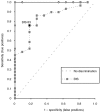Bispectral index versus COMFORT score to determine the level of sedation in paediatric intensive care unit patients: a prospective study
- PMID: 15693968
- PMCID: PMC1065097
- DOI: 10.1186/cc2977
Bispectral index versus COMFORT score to determine the level of sedation in paediatric intensive care unit patients: a prospective study
Erratum in
- Crit Care. 2005 Oct 5;9(5):426
Abstract
Introduction: Most clinicians give sedatives and analgesics according to their professional experience and the patient's estimated need for sedation. However, this approach is prone to error. Inadequate monitoring of sedation and analgesia may contribute to adverse outcomes and complications. With this in mind, data obtained continuously using nonstimulating methods such as bispectral index (BIS) may have benefits in comparison with clinical monitoring of sedation. The aim of this prospective observational trial was to evaluate the use of electroencephalographic (EEG) BIS for monitoring sedation in paediatric intensive care unit (PICU) patients.
Methods: Forty paediatric patients (<18 years) were sedated for mechanical ventilation in a cardiac surgical and general PICU. In each paediatric patient BIS and COMFORT score were obtained. The study protocol did not influence ongoing PICU therapy. BIS and corresponding COMFORT score were collected three times for each patient. Measurements with the best starting EEG impedances were analyzed further. Deep sedation was defined as a COMFORT score between 8 and 16, and light sedation as a score between 17 and 26. Biometric and physiological data, and Pediatric Risk of Mortality III scores were also recorded.
Results: There was a good correlation (Spearman's rho 0.651; P = 0.001) between BIS and COMFORT score in the presence of deep sedation and low starting impedance. Receiver operating characteristic (ROC) analysis revealed best discrimination between deep and light sedation at a BIS level of 83.
Conclusion: In the presence of deep sedation, BIS correlated satisfactorily with COMFORT score results if low EEG impedances were guaranteed.
Figures




Comment in
-
The use of bispectral index monitors in paediatric intensive care.Crit Care. 2005 Feb;9(1):25-6. doi: 10.1186/cc3001. Epub 2004 Nov 17. Crit Care. 2005. PMID: 15693977 Free PMC article.
References
-
- Ambuel B, Hamlett KW, Marx CM, Blumer JL. Assessing distress in pediatric intensive care environments: the COMFORT scale. J Pediatr Psychol. 1992;17:95–109. - PubMed
-
- Marx CM, Smith PG, Lowrie LH, Hamlett KW, Ambuel B, Yamashita TS, Blumer JL. Optimal sedation of mechanically ventilated pediatric critical care patients. Crit Care Med. 1994;22:163–170. - PubMed
-
- Burns AM, Shelly MP, Park GR. The use of sedative agents in critically ill patients. Drugs. 1992;43:507–515. - PubMed
Publication types
MeSH terms
LinkOut - more resources
Full Text Sources
Medical
Miscellaneous

